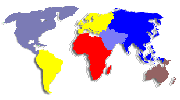|
The Lost Science of Money
A Speech at the US Treasury by Stephen Zarlenga
American Monetary Institute Monetary Reform Conference in Chicago Sept. 29 - Oct. 2, 2005
New Paradigm in Macroeconomics
Wherever the World Bank and the IMF became active – most of the developing world – they soon seemed to know the true problems of each country. Little local research was necessary to reach their
conclusions. Switching the country name from an earlier study seemed to do much of the job, since the policy advice is highly predictable and appears to apply to all countries: structural reform to implement
liberalization, deregulation and privatization, we are told, is the only path to prosperity. 
Debt Execution or Common Weal
A brief Exchange on Debt Restructuring between Nouriel Roubini and Kunibert Raffer
The Essence of Insolvency
and Chapter 9 of US Code on Bankruptcy
Before describing insolvency procedures pursuant to the US Chapter 9
in detail a brief general point about the essence of all insolvency regulations seems advisable to clarify their very essence. As already shown above there is the need for an efficient procedure to solve cases
of overindebtedness, as phantom debts otherwise continue to grow creating problems to anyone, including creditors. Historical evidence proves that even debt prisons cannot make unpayable debts paid. Once
it is clear that creditors cannot get all payments to which they are entitled, it becomes obvious that a procedure to share losses is necessary and advisable. Such procedures were developed by all
civilised legal systems. 
Is a USA Economic collapse due in 2005?
By F. William Engdahl 
James Cumes (*)
The US Dollar, Inflation
and the Outlook for 2004 
Inflation,Stagflation
and Unemployment 
Jahrbuch 2003
Europa
Ohne die Erweiterung zur Europäischen Währungsunion kann die EU nicht erfolgreich sein.
Arno Tausch:
Für ein gemeinsames €uropa
Argumente aus der Sicht des “Globalen Keynesianismus” 
Jahrbuch 2002 - IMF & Chapter 9
Solving Sovereign Debt Overhang
by Internationalising
Chapter 9 Procedure 
Working Paper by Kunibert Raffer
Luiz Inácio Lula da Silva`s Brazil: Financial cross double bind with JP Morgan Chase and partners - James K. Galbraith on “The Larger International Monetary Problem” 
Sovereign Debt Workout Arrangements / By Kunibert Raffer, University of Vienna 
Staatliche Schuldenregulierung: Verfahren und mögliche Inhalte / Ein Gutachten für das Bundesministerium für Wirtschaftliche Zusammenarbeit und Entwicklung 
IMF Updates and Patches: Mrs. Krueger`s software is approaching Microsoft standards 
A Contribution to an Online Discussion on Sovereign Debt Restructuring 
Moderated by the European Network for Debt and Development
A Letter By Thomas C. Dawson, Director, External Relations Department International Monetary Fund, February 7, 2002
Short Reply by Kunibert Raffer on request by DAD 
Jahrbuch 2001 / Bretton Woods
The Bretton Woods-GATT System: Retrospect and Prospect After Fifty Years 
Margaret Garritsen de Vries: The Bretton Woods Conference and the Birth of the International Monetary Fund 
Edward M. Bernstein: The Making and Remaking of the Bretton Woods Institutions 
US Dollar
Andre Gunder Frank:
Überdehnung der US-Ökonomie &
Militärisch-Politischer Rückstoß? 
Subversives Geld
Im Schatten der Derivate - Buchankündigung 
Jahrbuch 2000
Von Exuberance zu Protuberance
Negativer irrationaler Überschwang und spekulativer Empirismus
von Georg P. Christian
Man muß sich nicht wie ein Guru vorkommen, um die Voraussage zu wagen, daß der 20. Dezember 2000 in die Finanzgeschichte eingehen
wird – als der Tag, an dem »die Märkte« über die Blase, deren Aroma sie so lange gierig geschnüffelt haben und deren Binnendruck ihnen mitunter schon Ohren und Nasen zu verstopfen schien, von
immerwährender Betörung zunächst einmal in den Zustand der Verstörung übergegangen sind. 
Die Schwankungsanfälligkeit des
IWF-Systems
Ein Bericht von Georg P. Christian
Im Jahr 1988, zur Herbsttagung des Internationalen Währungsfonds
und der Weltbank in Berlin, hatten sich die Studien von Zeitfragen letztmals ausführlich mit »Fakten zur Schuldenkrise«, mit »Kampagne
und Gegenkongreß« sowie mit der Enzyklika Johannes Pauls II über die “Strukturen der Sünde” befaßt. (Heft 3/1988). Der Bericht schlägt die
Brücke zwischen den Umwälzungen Ende der 80er Jahre zum derzeitigen Zustand des Weltwirtschaftssystems. 
Hedge Funds, Asian Crisis and Japan
Von F. William Engdahl
In all today, there are some 3,000 registered trading entities called
hedge funds, with an estimated equity base of some $200 billions, according to Hedge Fund Research, Inc., a hedge fund analyst. Of these
, less than half a dozen regularly engage as conscious strategy, in high-risk, politically-targetted attacks on vulnerable currencies or markets.
While these »global macro« hedge funds, as the latter are often called, often operate out of offices in New York or other US cities, none of
them are »American« in any real sense. The management office may be in New York, but the legal corporation is hidden away, offshore, far
away from the prying eyes of US or other tax authorities, in places such as Netherlands Antilles or Cayman Islands. Further, to avoid any
legal scrutiny from US authorities, these global macro funds permit only non-US citizens or non-US institutional investors to join the equity share
of the fund, usually European or other foreign banks. It's all completely unregulated and highly secret. 
Weitere Beiträge zur Asienkrise 

|


